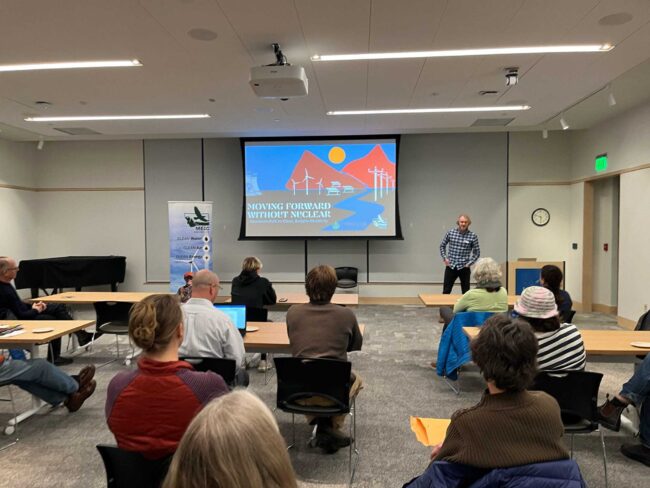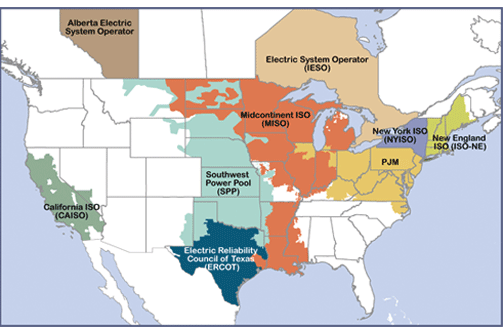by Nick Fitzmaurice
 Nick Fitzmaurice speaks to a group in Bozeman about the failed promises of “next-gen” nuclear generation. Photo by Anne Hedges.
Nick Fitzmaurice speaks to a group in Bozeman about the failed promises of “next-gen” nuclear generation. Photo by Anne Hedges.
As the climate crisis worsens and timelines for drastic transformations shrink, many advocates, in their search for significant, rapid emissions reduction solutions, have been turning recently to nuclear energy. While promises from the nuclear industry and its allies are alluring, as we’ve learned more about nuclear energy, we have to conclude that it’s not a viable path to rapidly and affordably meet Montana’s carbon-free energy needs and address the climate crisis.
The Roadblocks for Nuclear
As we’ve written about previously, small modular reactors (SMRs) are relatively new reactor designs that are touted as simpler, cheaper to operate, and safer than traditional pressurized water reactors. However, most of the hype surrounding SMRs is theoretical at this point, with only three SMRs ostensibly in operation globally (in Russia, China, and India). Little information is available on these facilities, while the U.S. Nuclear Regulatory Commission (NRC) approved its first SMR design for use in the U.S. only last year. Unfortunately, that approved SMR was NuScale’s project for Utah, which was canceled this fall due to runaway costs. Once again, nuclear has failed to live up to the hype.
While we’re interested in the benefits of this technology, it’s clear from this NuScale example that SMR technology has not escaped the ailments of previous nuclear energy technologies as exceedingly expensive, proving too expensive for any realistic near-term development. Current nuclear projects receive heavy subsidies from the Department of Energy and utility ratepayers that drastically exceed proportional subsidies to other energy sources. Nuclear could not compete in a competitive market against other carbon-free energy sources.
The last thing we need in Montana is for a failed nuclear project to saddle ratepayers with even higher electricity rates to pay for a facility that never generates electricity. If companies can somehow manage to drive down costs, these projects also suffer from runaway timelines and would not be viable for utility use for at least a decade, if not several. Given the need for rapid, affordable energy decarbonization and the immediate availability of alternative, affordable clean energy in wind and solar, nuclear does not foot the bill for addressing the climate crisis. Of course, this doesn’t even mention the traditional environmental and safety concerns posed by nuclear, such as the continued glaring issue of no long-term waste repository solution for spent radioactive nuclear fuel or uranium deposits that all-too-often are located near indigenous communities and mined without regard for impacts.
This winter, MEIC held a series of events discussing nuclear energy, SMRs, the context for nuclear energy in Montana, and alternative options for decarbonizing energy that are viable now. Our series began with a webinar featuring David Schlissel of the Institute for Energy Economics and Financial Analysis. David has been following and researching the development of nuclear energy for decades, and told our attendees his conclusions about “next-gen” nuclear energy:
- The US nuclear industry has repeatedly been unable to meet estimated costs and schedules.
- None of the SMR designs currently being marketed have been built.
- None of these designs (apart from NuScale’s) have been licensed in the US or Canada.
- Some proposals have exotic designs that have never been tried or have failed in the past.
- SMRs are not good tools for fighting climate change – they’re too expensive and take too long to build.
Finally, David cited the recent cancellation of NuScale’s Utah SMR project, announced in November after failing to secure enough customers to sign on for its service since the project was years overdue and billions of dollars over budget.
Meanwhile, there are readily available solutions that can ensure our lights stay on reliably and electricity remains affordable and is generated from clean and renewable energy sources.
With this foundation, Anne Hedges and I took off around the state to talk with Montanans about the plain facts of nuclear and what other solutions could fill our need for reliable, affordable energy.
The Alternative Solutions
While it is important to explore all options for a clean and affordable energy transition, the writing is on the wall for nuclear energy and the billions of investment dollars diverted from where it can truly make an impact in the energy transition. A large part of the equation is, of course, existing technology for wind and solar electricity generation paired with storage.
However, as we discussed in our events, available technologies go beyond renewables themselves to opportunities for transmission expansion and upgrades, energy efficiency and demand-side management investments, and advanced regional power-sharing markets. The 21st century grid can and must be managed in a more connected, efficient, and dynamic manner.
Renewable wind and solar energy are variable by nature, but this does not mean they are unreliable. When half of the Colstrip coal-fired power plant went down on Jan. 7 before a record-setting cold snap, winds soared and exceeded coal and gas generation to meet nearly half of NorthWestern Energy’s electricity demand with excess generation to export. We have barely tapped Montana’s abundant and cost-effective wind resource, which can be harnessed and paired with short- and long-duration storage systems to meet energy demands while capturing excess generation to dispatch once the winds die down. Bolstering Montana’s transmission network as part of a more advanced grid management system would then allow utilities to optimally and cost-effectively share power as it is available across the West (see article on pg. 16).
Energy markets unlock the benefits of an energy system that covers a greater geographic area than the weather. Winds often precede and follow weather events as a storm moves across a region, while solar availability varies based on regional cloud cover and time of day. Tapping into a larger region for energy generation through a market allows for these regional variabilities to complement one another in a reciprocal sharing of power resources. NorthWestern is currently a participant in the Western Energy Imbalance Market (EIM), having already realized over $74 million in economic benefits since joining the market in mid-2021. EIM is limited in functionality, only allowing energy trading for the next hour of a utility’s need, but MEIC hopes NorthWestern will soon join the Energy Day Ahead Market (EDAM) to expand on those benefits and stabilize market prices.
The final market evolution would be the creation of a West-wide Regional Transmission Organization (RTO), notably missing in the map of RTOs below. Read more about the benefits of energy markets and how we can bolster our electric grid to more effectively and affordably meet demand in record-setting events in the article on pg. 12.

This article was published in the March 2024 issue of Down To Earth.

